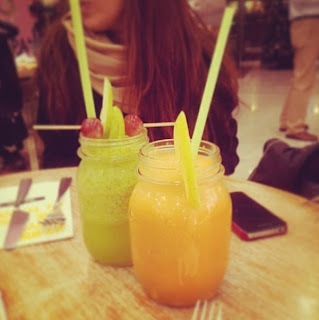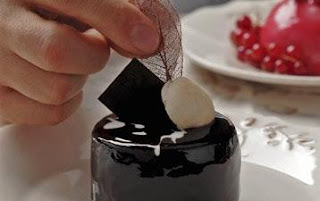Making food choices highly depend on a visual activity
as the food industry is well aware about this issue. Our sense of sight
separates the food as it looks good enough to eat before we touch and taste the
food.
Before we separate attractive and unattractive foods
we test the food through our individual, visual and smell experiences as well
as what others around us do with food.
Due to the reason it is important to conduct a
visually based research method which is particularly relevant with the tools
for explorations of food behavior.
By looking to the studies prepared before, it is
difficult to describe a general food behavior because daily food behaviors can
be challenging and it is much better to document food behavior via photography
or video rather than questionnaires or memory calls. Images of students plates were taken everyday not only show routine eating behaviors,
it also assists researchers in visualizing socio-cultural food norms and values
which might be hard to articulate with other means.
Plus, implementing visual recording into food relates
with fieldwork and because of that it is possible view the social life.
Due to all of these reasons, visually based
methodologies can particularly be useful in examinations of food in cultural
life.
Salad Bar /
School Lunch Program
Following photographs represents the comprehensive
evaluation of a salad bar school lunch program from several elementary schools
in Northern California/U.S.A. in 2004-2005 education periods.
As seen in the pictures, the school lunch salad bars
featured with bins of fresh fruits and vegetables in self-serve format, with
the intent of encouraging children to select(and consume) a wider variety and
greater amount of produce as part of their school lunch.
The self-serve aspect of the new school lunch salad
bar was the driving force to use photography as an evaluative device: during
the lunch-time hundreds of children went through the salad bar and it was
possible to take the pictures of their plate by using photography as an
evaluative device.
Researchers have taken 850 digital photographs of
individual students in 3 months in order to see the consumption habits and to
quantify the students serving sizes of various food components.
Researchers who controlled the products noticed
croutons and numbers of carrot coins on each plate which shows that the
children also feel free on arranging food on their plates.
Therefore, the researchers examined each plate as a
cultural construction. Due to the reason they first of all looked to the plates
which seem disgusting or weird for them.
The following pictures show the lunch selections of the
children.
The students encountered the bar from the left to
right, and would encounter the lettuce first, and then toppings like carrots
and cheese, followed by a variety of fresh fruit.
From this order of
ingredients students were expected to construct their plates such like their
teacher who is going through the same salad bar line
What adults planned?
The students encountered the bar from the left to right, and would encounter the lettuce first, and then toppings like carrots and cheese, followed by a variety of fresh fruit. From this order of ingredients students were expected to construct their plates such like their teacher who is going through the same salad bar line.
What kids did?
But the children’s selections were completely different as the following photographs shows the salads constructed by students in the elementary school.
When controlling the nutritional calculations it is seen that the students’ selections, salads met or exceed the nutritional requirements. So it is not impossible to say that their selections are wrong.
While children’s and teachers had similar components to organize their salads, their salads were visually different. Children’s plates typically showed careful arrangements of foods into piles, some into compositions worthy of flow chart. Children are generally not selecting mixed salads like their teachers.
The researchers firstly thought the students are unaware about how a proper salad should look like, but the students were insisting on rejecting mixed salad.
By checking other pictures the researches were sure about the students was no accident. The care and organization they use to decorate their tables shows that the students are thoughtful about their food choices and placements.
Creative Meal Combinations
The pictures also showed us the danger of allowing children to prepare their own combination. On the hot lunch days, the children have a very limited chance to prepare their plates due to the reason the children’s favorite day became salad bar days, and the students mention that “they felt like eating” on this days.
Also there were several control institutions which prohibits the children’s self-serve freedoms. This control was not about the nutritional components about the foods that they selected, that was mostly about the correct portion sizes and variety. Also the largest battle, between adults and children was fought over the portion size. Because the most popular items like cherries, strawberries, orange and kiwis were unavailable by the end of the first lunch period. This also has economical results.
Croutons:
Croutons were also popular and were used by children in creative ways different than adults. Since the croutons were located at the very end of salad bar, students were very careful that they save rooms for croutons in their trays that shows that children pay a lot of attention on the appearance of the food that they eat.
Finally, we see that when the children enjoyed the freedom to feed themselves, they can be very creative on the design of their trays.
Thus, we obtain the opportunity to gain new insights and understandings regarding to children’s food culture. Rather than building a mixed salad that adults generally prefer, children design their salad preparations very carefully and they separate the products that they prefer. This shows the importance of the appearance of food in their food culture.
Considering the people’s food habits of all ages and cultures are becoming increasingly important and we see the importance of “image based fieldworks” for food researcher.
Referance : http://cw.routledge.com/textbooks/9780415977777/resources/webchap27.pdf
The students encountered the bar from the left to right, and would encounter the lettuce first, and then toppings like carrots and cheese, followed by a variety of fresh fruit. From this order of ingredients students were expected to construct their plates such like their teacher who is going through the same salad bar line.
What kids did?
But the children’s selections were completely different as the following photographs shows the salads constructed by students in the elementary school.
When controlling the nutritional calculations it is seen that the students’ selections, salads met or exceed the nutritional requirements. So it is not impossible to say that their selections are wrong.
While children’s and teachers had similar components to organize their salads, their salads were visually different. Children’s plates typically showed careful arrangements of foods into piles, some into compositions worthy of flow chart. Children are generally not selecting mixed salads like their teachers.
The researchers firstly thought the students are unaware about how a proper salad should look like, but the students were insisting on rejecting mixed salad.
By checking other pictures the researches were sure about the students was no accident. The care and organization they use to decorate their tables shows that the students are thoughtful about their food choices and placements.
Creative Meal Combinations
The pictures also showed us the danger of allowing children to prepare their own combination. On the hot lunch days, the children have a very limited chance to prepare their plates due to the reason the children’s favorite day became salad bar days, and the students mention that “they felt like eating” on this days.
Also there were several control institutions which prohibits the children’s self-serve freedoms. This control was not about the nutritional components about the foods that they selected, that was mostly about the correct portion sizes and variety. Also the largest battle, between adults and children was fought over the portion size. Because the most popular items like cherries, strawberries, orange and kiwis were unavailable by the end of the first lunch period. This also has economical results.
Croutons:
Croutons were also popular and were used by children in creative ways different than adults. Since the croutons were located at the very end of salad bar, students were very careful that they save rooms for croutons in their trays that shows that children pay a lot of attention on the appearance of the food that they eat.
Finally, we see that when the children enjoyed the freedom to feed themselves, they can be very creative on the design of their trays.
Thus, we obtain the opportunity to gain new insights and understandings regarding to children’s food culture. Rather than building a mixed salad that adults generally prefer, children design their salad preparations very carefully and they separate the products that they prefer. This shows the importance of the appearance of food in their food culture.
Considering the people’s food habits of all ages and cultures are becoming increasingly important and we see the importance of “image based fieldworks” for food researcher.
Referance : http://cw.routledge.com/textbooks/9780415977777/resources/webchap27.pdf






















.jpg)










.jpg)
.jpg)
.jpg)





.jpg)

.jpg)
.jpg)




.jpg)